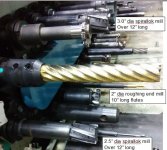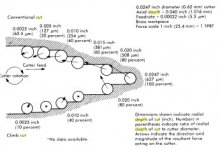BRIAN.T
Cast Iron
- Joined
- Jul 23, 2018
- Location
- Los Angeles
I've been pondering a few things lately, so I'll ask you guys.
Question one, with all things equal, do you guys step down or step over. Now obviously most of the time there is an obvious logic behind one or the other. But certainly there are other times when either one would do. I personally find myself stepping over. Is there a definitive reason to gravitate towards one of the other.
Second, again variables aside, in a situation where your material removal rate is equal, either by high speed, low stepover or low feed high stepover, which would be less aggressive on the part. Obviously high speed is better for the tool, chip thinning and all, but which is better on the part. Say to keep a part from pulling out of a vise. Im not sure. Any ideas?
Discuss!
Question one, with all things equal, do you guys step down or step over. Now obviously most of the time there is an obvious logic behind one or the other. But certainly there are other times when either one would do. I personally find myself stepping over. Is there a definitive reason to gravitate towards one of the other.
Second, again variables aside, in a situation where your material removal rate is equal, either by high speed, low stepover or low feed high stepover, which would be less aggressive on the part. Obviously high speed is better for the tool, chip thinning and all, but which is better on the part. Say to keep a part from pulling out of a vise. Im not sure. Any ideas?
Discuss!




